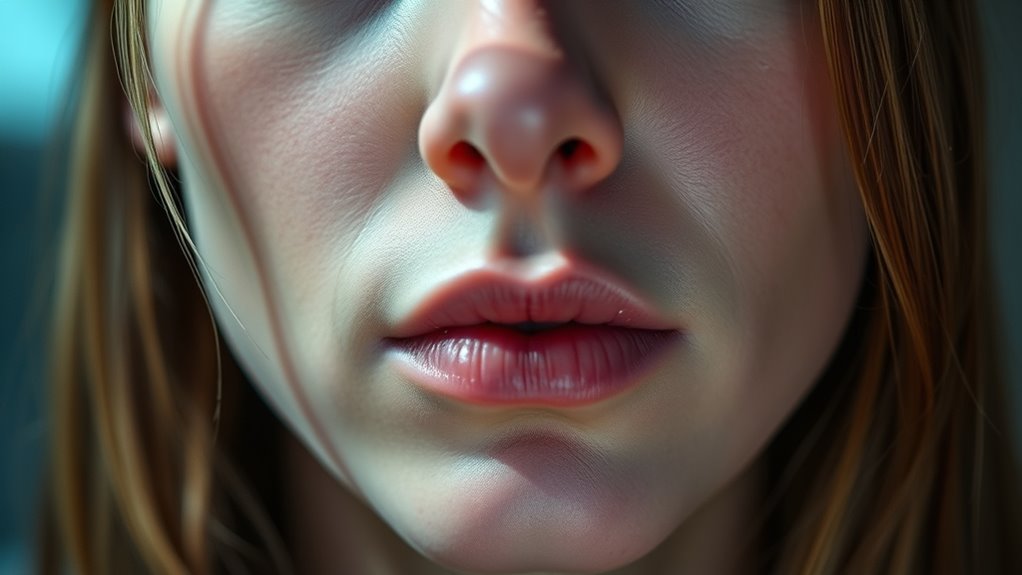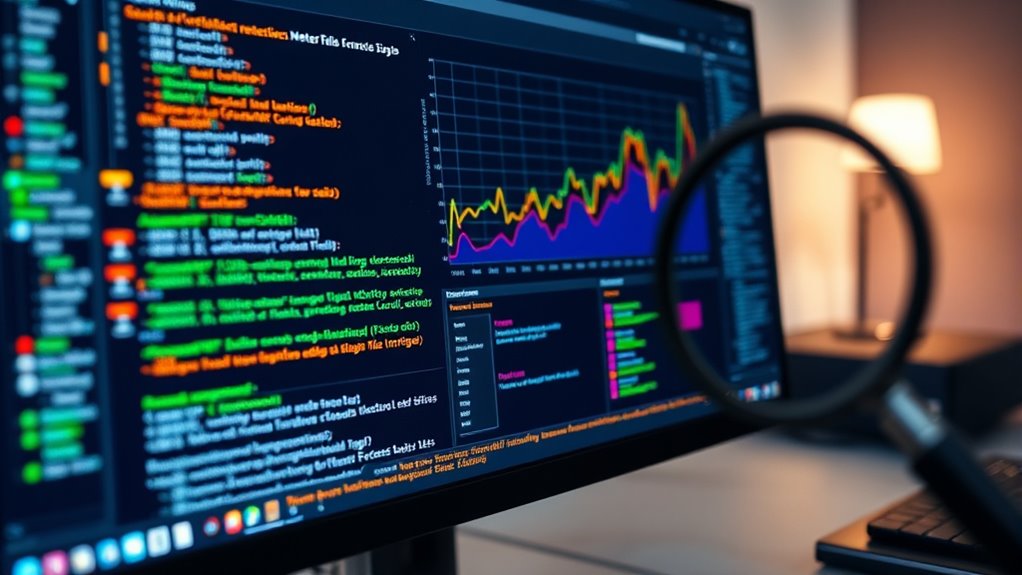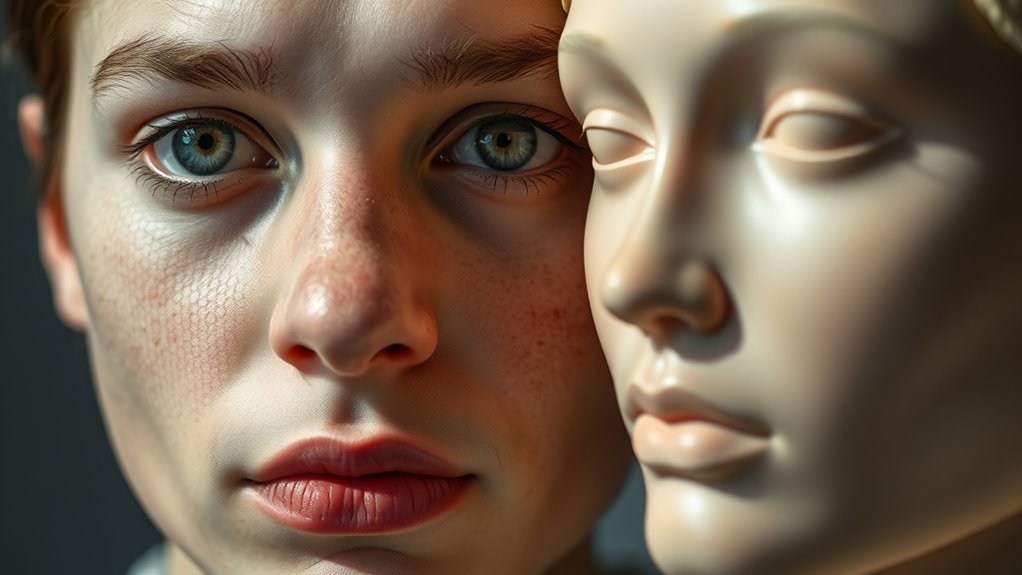To spot machine-made imposters quickly, examine the image for inconsistencies like blurry edges, unnatural reflections, or distorted textures. Check the language for repetitive phrases, stiff tone, or odd phrasing that feels robotic. Use reverse image searches to find matching sources and analyze metadata for signs of tampering. Also, look for facial or object asymmetry, as real images tend to be more balanced. If you want to get better at noticing these signs, there’s more to explore below.
Key Takeaways
- Examine image edges, lighting, reflections, and textures for inconsistencies indicating manipulation or AI generation.
- Look for repetitive phrases, uniform language, and unnatural tone shifts in text to spot automation.
- Use AI-detection tools and reverse image searches to identify signs of machine-made images or altered content.
- Check metadata, file origin, and source credibility to verify authenticity and detect tampering.
- Assess facial and object symmetry, as natural features are typically symmetrical; asymmetry may suggest editing.
Analyzing Inconsistencies in Image Details

When examining an image for signs of fakery, inconsistencies in details often reveal whether it’s genuine or manipulated. Look closely at the edges of objects—blurred or mismatched borders can indicate editing. Check the lighting and shadows; if they don’t align with the scene’s light source, the image might be altered. Pay attention to reflections, especially in mirrors or windows—unnatural or inconsistent reflections suggest tampering. Examine textures and patterns, such as hair, fabric, or background details; uneven or distorted areas can be red flags. Also, scrutinize the proportions and anatomy—distorted features or disproportionate elements often signal manipulation. By systematically evaluating these details, you can better identify whether an image is authentic or digitally altered. Using detailed analysis techniques can further improve your ability to spot subtle signs of editing.
Checking for Unnatural Language and Tone

Pay attention to language that feels repetitive or overly stiff; it often signals machine-generated text. Notice if the tone shifts suddenly or seems too formal or informal for the context, which can be a red flag. Also, watch for inconsistencies in voice and style that don’t match the rest of the content. Additionally, utilize passive voice detection tools to identify and correct passive constructions that may indicate automation.
Repetitive Phrase Patterns
Repetitive phrase patterns can reveal that a text is machine-generated, as algorithms often rely on similar word choices and sentence structures. When reading, look for phrases or sentence openings that repeat frequently or follow a predictable pattern. Machines tend to reuse certain expressions or sentence frameworks, making the writing feel monotonous or robotic. Notice if the language feels overly uniform, with little variation in tone or vocabulary. These patterns can indicate that the text was produced by an AI or automated tool rather than a human. By paying attention to recurring phrases or repetitive sentence styles, you can spot signs of artificial authorship. Recognizing these patterns helps you differentiate between genuine human writing and machine-generated content more effectively. Additionally, distinctive language traits such as inconsistent tone shifts or awkward phrasing can further signal automated composition.
Excessive Formality or Informality
Unnatural language often reveals machine-made texts because algorithms tend to use overly formal or inconsistent tones that don’t match natural speech. If the writing sounds too stiff, overly polished, or strangely inconsistent in tone, it’s a red flag. Machines often struggle to match the casual flow of human conversation, so their words can come across as awkward or unnaturally formal. Conversely, some AI-generated texts may seem too informal or slang-heavy, which can also seem off in the context. Pay attention to shifts in tone or language that don’t fit the overall style. If the tone feels mismatched or artificially rigid, it’s likely a sign you’re dealing with a machine-made imposter. Stay alert for these unnatural cues to spot potential fakes. Additionally, a lack of understanding of complex concepts like credit card security can also be a giveaway of machine-generated content.
Inconsistent Voice and Style
When examining a text, look for inconsistencies in voice and style, as these often signal machine-generated content. Machines tend to switch tones or use language that doesn’t match the overall flow. To spot this, pay attention to shifts in word choice, sentence structure, or formality levels. Here’s a quick guide:
| Sign | Example | What it Means |
|---|---|---|
| Tone shifts | Formal to casual | Possible machine writing |
| Unnatural phrasing | Awkward or repetitive | Automated generation |
| Inconsistent vocabulary | Jumps between simple and complex | Lack of cohesive voice |
If the tone feels inconsistent or the language seems off, it’s a strong sign the content might be machine-made. Trust your instincts and dig deeper. Additionally, consistent style is a key indicator of human-authored content, as it reflects deliberate editing and voice development.
Examining Metadata and File Origins

You can often spot fakes by checking the file metadata for inconsistencies. Analyzing creation details helps reveal if the file’s origin matches the claimed source. Verifying the source’s authenticity confirms whether the file is genuine or potentially manipulated. Additionally, examining metadata can help identify signs of content manipulation or edited data that might indicate a fake.
Check File Metadata
How can examining file metadata reveal whether an image or document is genuine or altered? Metadata contains details like creation date, software used, and file history, which can expose inconsistencies. Look for mismatched dates or unexpected software names that don’t align with the context. For example, a photo claiming to be from 2010 but created with recent editing tools raises suspicion. Use tools like EXIF viewers or file properties to access metadata. Here’s a quick comparison:
| Metadata Element | What to Check | Why It Matters |
|---|---|---|
| Creation Date | Is it consistent with the event? | Inconsistent dates suggest edits |
| Software Used | Is it appropriate for the file? | Unusual software hints manipulation |
| File History | Are there unexpected modifications? | Frequent changes can indicate tampering |
Additionally, examining the integrity of file formats can help determine authenticity, as certain formats have characteristics that are difficult to forge. Careful examination can help you spot fakes quickly.
Analyze Creation Details
Examining the creation details of a file involves scrutinizing its metadata and origins to verify authenticity. Start by checking the file’s metadata for inconsistencies or missing information, such as creation and modification dates, author details, or device information. Look for signs of tampering, like sudden date changes or conflicting data. Investigate the file’s origin by tracing its source—where it was created and how it arrived in your possession. Genuine files often contain consistent timestamps and originate from trusted sources. Be cautious if metadata is blank, altered, or inconsistent with the file’s context. Additionally, understanding the history of pinball machines can help identify genuine files related to the topic versus fabricated content. These clues help you determine if a file was artificially generated or manipulated, giving you a clearer picture of its legitimacy before moving on to more detailed verification steps.
Verify Source Authenticity
To verify the authenticity of a file’s source, start by closely examining its metadata and origin details. Metadata reveals essential information like creation date, author, device used, and modification history, helping you identify inconsistencies or signs of manipulation. Check the file’s origin—where it was created or downloaded from—and compare it with the claimed source. Look for discrepancies such as mismatched dates, unusual editing software, or unfamiliar authorship. Use trusted tools to extract and analyze metadata without altering it, ensuring integrity. If metadata or origin details seem suspicious or don’t align with the context, consider the possibility of deception. Verifying these details helps you determine whether the file is genuine or a fabricated imposter. Additionally, Pimple Patch information can be relevant if the file pertains to skincare products, ensuring the content’s credibility.
Using Reverse Image Search for Verification

When you suspect an image might be a fake, performing a reverse image search can quickly reveal its origins and authenticity. Upload the image or input its URL into a reverse image search tool like Google Images or TinEye. These tools scan the internet for matching images and display where else the image appears online. If the search shows the image in unrelated contexts or with altered details, it’s a red flag. Conversely, finding the image in reputable sources or with consistent appearances helps confirm its legitimacy. Reverse image searches can uncover if an image has been manipulated, taken out of context, or recycled from other sources. Use this quick test to verify images before trusting their authenticity, especially when dealing with sensitive or controversial content. Additionally, checking for regional culinary details in the image can help determine if it aligns with local ingredients or themes.
Observing Facial and Object Symmetry

After using reverse image search to check a picture’s origins, observing the symmetry of faces and objects can reveal signs of manipulation. Human faces are inherently symmetrical, so uneven features or distorted proportions often indicate edits or AI generation. Look closely at facial features—misaligned eyes, asymmetrical mouths, or uneven ears are red flags. Similarly, examine objects for unnatural symmetry, such as mismatched sides or irregular shapes. Authentic images tend to have consistent, balanced features, while fake ones often display subtle asymmetries or distortions. Trust your instincts if something looks off. By paying attention to these details, you can better spot images that might be artificially created or manipulated. Symmetry checks serve as quick, effective indicators of authenticity.
Employing AI-Detection Tools

Using AI-detection tools can considerably improve your ability to identify artificially generated or manipulated images. These tools analyze images for telltale signs of machine creation, such as unusual pixel patterns, inconsistent lighting, or unnatural textures. When you run an image through an AI-detection app, it highlights areas that may have been altered or generated. Many tools provide a confidence score, helping you decide whether the image is likely genuine or synthetic. Keep in mind, no tool is foolproof, so use them as part of your overall assessment. Regularly updating your detection tools ensures you’re catching the latest manipulations. By integrating AI-detection software into your verification process, you gain a quick, reliable way to spot machine-made imposters with greater confidence.
Frequently Asked Questions
How Reliable Are Ai-Detection Tools Across Different Image Types?
You want to know how reliable AI-detection tools are across various image types. These tools can be quite effective with high-quality, clear images, but their accuracy drops with complex or low-resolution pictures. They’re better at spotting machine-made images when the AI algorithms are well-trained on diverse datasets. However, no tool is perfect, so you should use them as part of a broader verification process, not the sole method.
Can Metadata Be Easily Manipulated to Hide Signs of Fakery?
Metadata is like a digital footprint—easily altered if you know how. You might think it can hide signs of fakery, but savvy detectives can spot inconsistencies or trace modifications. While manipulations can be subtle, they aren’t foolproof. You should always verify image authenticity through multiple methods, because relying solely on metadata is like trusting a map that’s been deliberately distorted. It’s a useful clue, but not the whole story.
Are There Specific Visual Cues That Indicate Machine-Made Impersonation?
When you look for signs of machine-made impersonation, you should pay attention to small details. You might notice unnatural smoothness in skin, inconsistent lighting or shadows, and repetitive patterns that don’t quite match real images. These artificial cues often stand out when you examine images closely. By focusing on these visual clues, you can better identify whether an image is genuinely human-made or generated by a machine.
How Do Cultural or Artistic Styles Affect Authenticity Assessments?
When evaluating authenticity, you should consider how cultural or artistic styles influence your judgment. Different styles have unique characteristics that can signal originality or indicate machine-made imitations. If an artwork unexpectedly blends styles or lacks traditional details, it might be a sign of impersonation. Your familiarity with specific cultural nuances helps you identify subtle clues, making it easier to distinguish authentic pieces from machine-made reproductions.
What Are the Limitations of Reverse Image Searches in Spotting Fakes?
You might think reverse image searches are foolproof for spotting fakes, but they have limitations. They rely on existing online data, so if a fake isn’t widely circulated or new, it’s unlikely to appear. Also, images can be altered or low-quality, making matches hard. Consequently, reverse image searches shouldn’t be your only tool; combine them with other methods for a more accurate assessment.
Conclusion
By analyzing inconsistencies, checking for unnatural language, examining metadata, using reverse image searches, observing symmetry, and employing AI-detection tools, you sharpen your skills to spot machine-made imposters. Each test sharpens your eye, each check hones your intuition, each method builds your confidence. Stay vigilant, stay curious, stay critical. With practice, you’ll become more adept at uncovering fakes, more confident in your judgment, more skilled at protecting yourself from deception.









